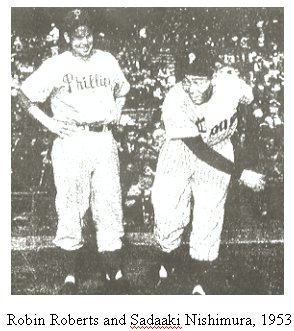
Can we say the Japanese have come up to the major league level? Is Japanese
baseball to follow the path of cameras, cars, and electronics?
Kazuo Sayama,
baseball historian,
1991
LAND OF THE RISING BASEBALL
By John B Holway
Can you believe it? Japan beat Team USA 9-4! Another humiliating loss for the Americans, once the unchallenged monarchs of the baseball world back when the World Series was still the “world” series.
It’s been 75 years in coming.
In 1934 Babe Ruth, Lou Gehrig, Jimmie Foxx, Lefty Grove, and others visited Japan . Babe played outfield with a parasol. Al Simmons laid down and took a rest in left field. Lou covered first base in galoshes.
 Then they ran into an 18 year-old high school
kid named Eiji Sawamura. He struck out Charlie Gehringer, Ruth, Gehrig, and
Foxx in order before Gehrig homered to beat him 1-0. (Sawamura died when
his troopship was torpedoed off Taiwan in World War II.)
Then they ran into an 18 year-old high school
kid named Eiji Sawamura. He struck out Charlie Gehringer, Ruth, Gehrig, and
Foxx in order before Gehrig homered to beat him 1-0. (Sawamura died when
his troopship was torpedoed off Taiwan in World War II.)
My first look at Japanese baseball came in 1948. I saw kids playing on pebble-strewn lots, running down grounders in geta, the wooden clogs that stood an inch or two off the ground. I couldn’t believe it. I had to shake my head and blink, but they were doing it.
I enjoyed the Japanese pro games, which had their own heroes and were pretty exciting. Tetsuji Kawakami, “the god of batting,” was called the Japanese Gehrig.
My favorite player, pitcher Shoichi Kaneda, resembled Sandy Koufax; he would win 400 games and pile up 4,000 strikeouts, breaking Walter Johnson’s then “world” record.
In 1953 the American all stars – Yogi Berra, Robin Roberts, Enos Slaughter, etc – arrived. The first batter, Harvey Kuenn, strode to home plate, the Japanese catcher got up from his squat – and he barely came up to Harvey’s shoulders. It was like watching a puppet show when at the final curtain the puppeteer suddenly pokes his giant face into the proscenium. You gasp in shock.
The Americans romped to victory in 14 of 15 games by scores of 16-2, 11-1, 9-0 etc.
Hank Sauer was given a motorcycle for blasting a ball over the bleachers at Korakuen Stadium. It may have been the first time anyone had done it.
Even Kaneda was cuffed around freely by the big gaijin, or foreigners.
Leo Durocher of the New York Giants held a pre-game clinic and bawled the Japanese out like high school kids for missing cutoffs or other sins. I called him at his hotel to say, “These guys are big stars here. You shouldn’t make them lose face in front of their fans..” Leo told me what I could do with their face.
But a few days later a little submarine pitcher named Hideki Otomo shut Leo’s Giants out for nine innings, and the eighth-place hitter poled a homer off Hoyt Wilhelm to win 1-0. It’s still considered one of the ten greatest games in Japanese history.
When I talked to two of the U.S. All Stars, Ed Mathews and Kuenn, both were impressed by some good “leather-men” shortstops on the Japanese teams.
And in one home-run hitting contest, the Japanese king, Futoshi Nakanishi, tied the American champ, Mathews.
In 1955 I wrote a book, Japan Is Big League In Thrills, and predicted that Japanese would be playing in the U.S. big leagues in a generation.
I was wrong. It took less than a decade.
In 1954 Masanori Murakami was pitching for the San Francisco Giants, and for two years he was one of the most effective relief aces in the majors. Also one of the most popular. When a fielder made a good play behind him, he swept off his cap and bowed thanks. But the Japanese demanded that he come home, where he never was able to repeat the success he had achieved in America .
But little by little every autumn the Japanese were winning two, three, or four more games against the Americans.
Finally, in 1970 Japan beat the San Francisco Giants six games to three.
In 1990 they did it again against an all-star squad of Barry Bonds, Ken Griffey Jr, Cecil Fielder, Randy Johnson, Dave Stewart etc. Japan swept the first four games before the Americans shook off their jet lag and won a game. They ended the tour with one tie and two more wins. The last one was a no-hitter by Chuck Finley and Johnson over Japanese rookie Hideo Nomo.
At one time Japanese players held four world records – home runs, strikeouts, consecutive games played (Sachio Kinugasa, the son of a black GI), and stolen bases (Yutaka Fukumoto).
Americans scoffed that the marks weren’t made against big league opposition. However, Fukumoto stole six out of seven against the Americans, including a steal of home against Johnny Bench.
And when Sadahara Oh met Hank Aaron in a home run contest, Hank narrowly won it, nine homers to eight.
More important, the two champs could have traded uniforms. Quietly, over the decades, the Japanese had grown just about as big as the Yanks.
What of the future? Are we looking at a real World Series between the winner of the U.S. and the champion of Japan ? Stranger things could happened.
They already have.
_______
John B Holway is author of TED, the Kid